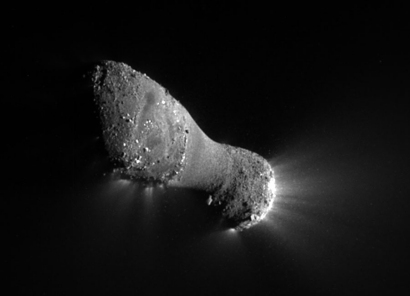A comet not far from Earth has shed some light on how our planet could have  come by much of its water, a new study has revealed.
come by much of its water, a new study has revealed.
Writing in Nature, Paul Hartogh, who is based at Germany's Max Planck Institute for Solar System Research, used ESA's orbiting Hershel Space Observatory to study a small 1.5 kilometre-wide comet called 103P/Hartley 2, which formed originally out in the Kuiper Belt beyond the orbit of Pluto and now follows a 6.5 year elliptical orbit in the region of space between the Earth and Jupiter.
Hartogh and his colleagues probed the comet's "coma" - the pall of dust and debris thrown off by the body as it is warmed by the Sun - for the telltale-traces of water. Specifically, they were looking at the relative proportions of "heavy" hydrogen - or deuterium - that were present.
Water on Earth contains about one atom of deuterium for every 6500 atoms of "light" hydrogen. This a close match for the levels seen in asteroids and many meteorites but about half as large as the levels seen in other comets that have been measured far out in deep space in a region called the Oort cloud.
Consequently, space scientists had concluded that when the Earth first formed it was a hot, dry and barren rock that, as it cooled sufficiently for liquids to condense, was progressively wetted by the arrival of water-laden asteroids. Comets, they thought, must have been a relatively rare contributor to the planet's early water supply.
However, the observations from 103P/Hartley turn this idea on its head. The comet shows a deuterium-hydrogen fingerprint that is almost exactly the same as Earth's own water. It also reveals some interesting details about the birthplaces of the comets themselves and therefore the structure of the early solar system.
Comets like 103P/Hartley are thought to have formed in the Kuiper Belt, about 50 times further from the Sun than Earth is, and then migrated inwards later. Conversely, more distant comets like those now in the Oort Cloud and over 5000 times the Earth-Sun distance away, are thought originally to have been born near Jupiter before being gravitationally booted into the outer reaches of the solar system later.
But because these Oort Cloud comets formed closer to the Sun originally, and therefore would have been exposed to higher temperatures, they should have a lower deuterium-hydrogen ratio than their Kuiper Belt counterparts that formed under cooler conditions.
Instead the scientists have found the opposite. This argues that something is out of kilter in our understanding of the formation of the early Solar system, but it will take further cometary chemical forensics, like that announced by Hartogh, to ultimately reveal the answer...









Comments
Add a comment